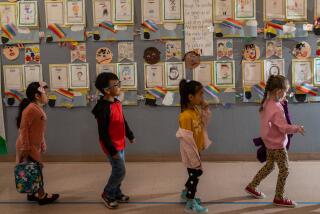Deaf Infants Say ‘Goo-Goo’ in Sign Language : Language: Findings indicate babies’ manual and vocal babblings are inherent in the growing brain.
New studies of “babbling” in hand gestures by deaf infants indicate that the development of language abilities in humans--both spoken and signed language--follows a rigid pattern dictated by the organization of the brain.
The new results indicate that both manual and vocal babbling are inherent characteristics of the growing brain as it learns the structure of language, Canadian researchers report today in the journal Science.
Linguists and psychologists have long recognized that babbling is not simply a random uttering of sounds, but the first stage in the acquisition of language abilities. As such, it follows a very precise pattern.
Researchers know, for example, that babbling incorporates only some of the sounds used in the parents’ language and that syllables--combinations of consonants and vowels--occur with high frequency. These syllables are often repeated, as in “dadada” or “goo-goo.”
Furthermore, the babbling increases in complexity on a specific timetable and the syllables involved in the babbling also appear in the first meaningful words spoken by the children around 14 months of age.
Now, the Canadian scientists report that the same evolution of language appears to take place in deaf infants who are exposed to sign language.
The findings provide strong support for the arguments of linguists such as Noam Chomsky of the Massachusetts Institute of Technology that the human brain has specific biological programming that gives humans the innate capacity for language, said linguist Lila Gleitmanof the University of Pennsylvania.
“What you’re seeing here is that language . . . behaves the same way no matter how it is realized,” she said. “So, in my favorite old phrase, ‘Deny it to the mouth and it will dart out through the fingers.’ ”
Simply put, the new results “tell us that language is distinct from speech,” said psychologist Laura Ann Pettito of McGill University in Montreal, Quebec. “Speech is only one of the signals that the human body has available to it.”
Pettito and Paula F. Marentette of McGill studied five infants, who were videotaped at ages 10, 12 and 14 months. Two were deaf infants of deaf parents who were acquiring American Sign Language as a first language. The other three were hearing children with no exposure to sign language.
In studies of vocal babbling, researchers typically transcribe all sounds produced over a specific period of time and analyze all sounds that are not words to see if they have any systematic organization. If such organization is found, the researcher determines whether the organization has phonetic and syllabic features common to spoken languages.
Pettito and Marentette analyzed the hand motions of the five children in exactly the same manner. They found that the hand motions of the deaf children met all the criteria for babbling as much as 71% of the time, while those of the hearing children met the same criteria no more than 15% of the time.
In addition to using the signs and motions characteristic of American Sign Language, the deaf children also passed through the same stages that are observed in vocal babbling. At the age of 10 months, the babbling was restricted primarily to syllables and those syllables were repeated frequently.
This manual babbling, they said, was the semantic equivalent of “goo-goo” and “dadada” and, like those phrases, had no specific meaning.
Beginning about 12 months, the deaf children produced so-called jargon babbling--meaningless babbling sequences that “maintained the rhythm and duration of rudimentary American Sign Language sentences,” Pettito said. Finally, the first meaningful words produced by the children incorporated the signs that they had used most frequently in babbling.
The fact that babbling occurs on the same timetable in both hearing and non-hearing infants indicates that muscle development of either the vocal system or the hands is not the critical factor in babbling.




